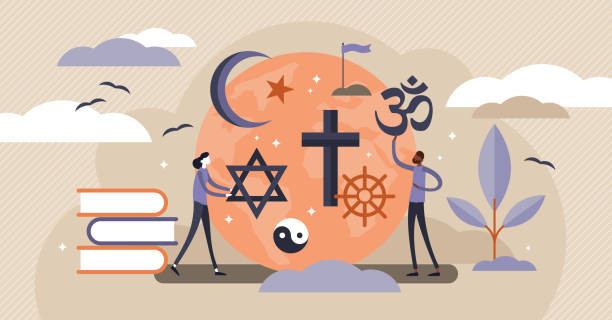Your Religion is Your Faith:-
How has increased interconnectedness influenced religious practices and beliefs?
By Hugo Keji
Increased interconnectedness, a hallmark of globalization, has significantly influenced religious practices and beliefs in several ways.
This interconnectedness, driven by advancements in communication, transportation, and technology, has facilitated the exchange of ideas and practices across religious boundaries, leading to both transformation and innovation within religious traditions.
Here are some key ways this has manifested:
1. Diversification and Syncretism
Blending of Religious Traditions: Increased contact between different religious groups has led to the blending of practices and beliefs, a phenomenon known as syncretism. For example, some religious ceremonies might incorporate elements from multiple faiths, reflecting the multicultural environments in which they are practiced.
Personalized Spirituality: Individuals now have access to a wide array of religious ideas and practices, allowing them to create more personalized forms of spirituality. People might adopt meditation techniques from Buddhism, ethical principles from Christianity, and rituals from indigenous traditions, crafting a unique spiritual path that resonates with their personal experiences and worldview.
2. Adaptation to Modern Contexts
Reinterpretation of Doctrines: Religious doctrines and teachings have been reinterpreted in light of contemporary issues and global challenges. For instance, many religious leaders and communities have reexamined their stances on topics like environmental stewardship, gender equality, and human rights, aligning their beliefs with global ethical standards.
Integration of Technology: Religious practices have increasingly incorporated technology, such as online worship services, virtual religious communities, and digital religious texts. This adaptation has made religious practices more accessible, especially for those who may not be able to participate in traditional, in-person gatherings.
3. Strengthening of Religious Identity
Revival Movements: In response to the global spread of secularism and religious pluralism, some religious groups have experienced a revival, emphasizing a return to core beliefs and practices. This can be seen in the growth of movements that stress traditional religious values and resist external influences.
Global Religious Communities: The formation of global religious networks has allowed believers to maintain and even strengthen their religious identity despite being geographically dispersed. Social media, online forums, and streaming services have enabled people to participate in religious communities that transcend national and cultural boundaries.
4. Interfaith Dialogue and Cooperation
Increased Interfaith Engagement: The interconnectedness of the modern world has fostered greater interfaith dialogue and cooperation. Religious groups often collaborate on social justice issues, humanitarian aid, and peace-building efforts. These interactions have led to a greater understanding and respect for diverse religious traditions.
Shared Ethical Concerns: Many religions have found common ground on global issues such as poverty, environmental sustainability, and human rights. This shared focus has led to joint initiatives that transcend religious differences, fostering a sense of global responsibility and ethical commitment.
5. Challenges to Traditional Practices
Cultural Dilution: The widespread dissemination of global culture can sometimes dilute traditional religious practices, especially when they are commercialized or secularized. For example, religious festivals might lose some of their spiritual significance as they become popularized in broader cultural contexts.
Pressure to Modernize: Traditional religious practices that are seen as outdated or incompatible with modern values may face pressure to change. This can lead to tensions within religious communities as they balance the preservation of tradition with the need to remain relevant in a rapidly changing world.
6. Influence of Global Migration
Migration and Religious Diasporas: The movement of people across borders has led to the establishment of religious diasporas, where migrant communities maintain their religious practices in new cultural contexts. These communities often adapt their practices to fit their new environment, blending their traditions with local customs.
Cross-Cultural Religious Influence: Migrants and travelers bring their religious beliefs and practices to new regions, influencing local religious landscapes. This can lead to the introduction of new religious ideas, the revitalization of existing practices, or the creation of entirely new religious expressions.
Increased interconnectedness has deeply influenced religious practices and beliefs, leading to both innovation and adaptation within religious traditions.
While this has enriched religious life by fostering diversity and dialogue, it has also posed challenges to the preservation of traditional practices.
The dynamic interplay between global influences and local religious identities continues to shape the evolving landscape of world religions.
App link: FREE for download... https://www.amazon.com/dp/...
How has increased interconnectedness influenced religious practices and beliefs?
By Hugo Keji
Increased interconnectedness, a hallmark of globalization, has significantly influenced religious practices and beliefs in several ways.
This interconnectedness, driven by advancements in communication, transportation, and technology, has facilitated the exchange of ideas and practices across religious boundaries, leading to both transformation and innovation within religious traditions.
Here are some key ways this has manifested:
1. Diversification and Syncretism
Blending of Religious Traditions: Increased contact between different religious groups has led to the blending of practices and beliefs, a phenomenon known as syncretism. For example, some religious ceremonies might incorporate elements from multiple faiths, reflecting the multicultural environments in which they are practiced.
Personalized Spirituality: Individuals now have access to a wide array of religious ideas and practices, allowing them to create more personalized forms of spirituality. People might adopt meditation techniques from Buddhism, ethical principles from Christianity, and rituals from indigenous traditions, crafting a unique spiritual path that resonates with their personal experiences and worldview.
2. Adaptation to Modern Contexts
Reinterpretation of Doctrines: Religious doctrines and teachings have been reinterpreted in light of contemporary issues and global challenges. For instance, many religious leaders and communities have reexamined their stances on topics like environmental stewardship, gender equality, and human rights, aligning their beliefs with global ethical standards.
Integration of Technology: Religious practices have increasingly incorporated technology, such as online worship services, virtual religious communities, and digital religious texts. This adaptation has made religious practices more accessible, especially for those who may not be able to participate in traditional, in-person gatherings.
3. Strengthening of Religious Identity
Revival Movements: In response to the global spread of secularism and religious pluralism, some religious groups have experienced a revival, emphasizing a return to core beliefs and practices. This can be seen in the growth of movements that stress traditional religious values and resist external influences.
Global Religious Communities: The formation of global religious networks has allowed believers to maintain and even strengthen their religious identity despite being geographically dispersed. Social media, online forums, and streaming services have enabled people to participate in religious communities that transcend national and cultural boundaries.
4. Interfaith Dialogue and Cooperation
Increased Interfaith Engagement: The interconnectedness of the modern world has fostered greater interfaith dialogue and cooperation. Religious groups often collaborate on social justice issues, humanitarian aid, and peace-building efforts. These interactions have led to a greater understanding and respect for diverse religious traditions.
Shared Ethical Concerns: Many religions have found common ground on global issues such as poverty, environmental sustainability, and human rights. This shared focus has led to joint initiatives that transcend religious differences, fostering a sense of global responsibility and ethical commitment.
5. Challenges to Traditional Practices
Cultural Dilution: The widespread dissemination of global culture can sometimes dilute traditional religious practices, especially when they are commercialized or secularized. For example, religious festivals might lose some of their spiritual significance as they become popularized in broader cultural contexts.
Pressure to Modernize: Traditional religious practices that are seen as outdated or incompatible with modern values may face pressure to change. This can lead to tensions within religious communities as they balance the preservation of tradition with the need to remain relevant in a rapidly changing world.
6. Influence of Global Migration
Migration and Religious Diasporas: The movement of people across borders has led to the establishment of religious diasporas, where migrant communities maintain their religious practices in new cultural contexts. These communities often adapt their practices to fit their new environment, blending their traditions with local customs.
Cross-Cultural Religious Influence: Migrants and travelers bring their religious beliefs and practices to new regions, influencing local religious landscapes. This can lead to the introduction of new religious ideas, the revitalization of existing practices, or the creation of entirely new religious expressions.
Increased interconnectedness has deeply influenced religious practices and beliefs, leading to both innovation and adaptation within religious traditions.
While this has enriched religious life by fostering diversity and dialogue, it has also posed challenges to the preservation of traditional practices.
The dynamic interplay between global influences and local religious identities continues to shape the evolving landscape of world religions.
App link: FREE for download... https://www.amazon.com/dp/...
1 yr. ago

